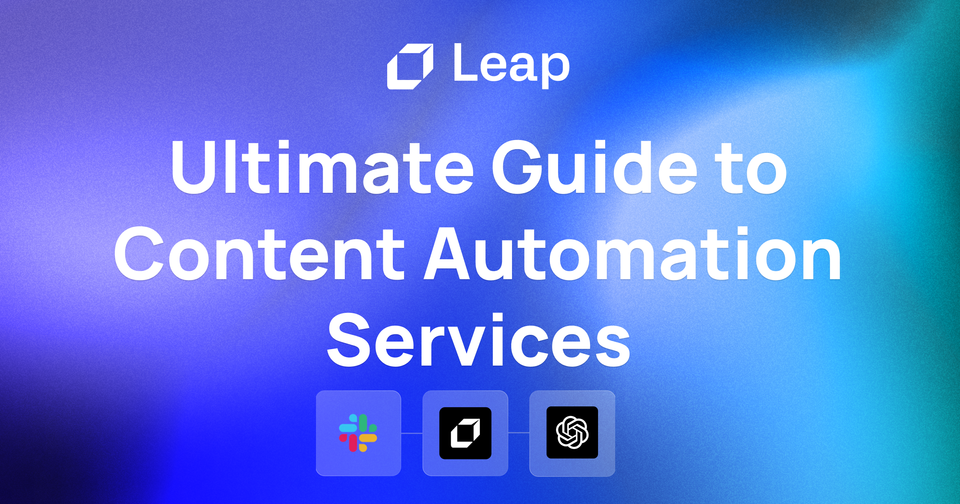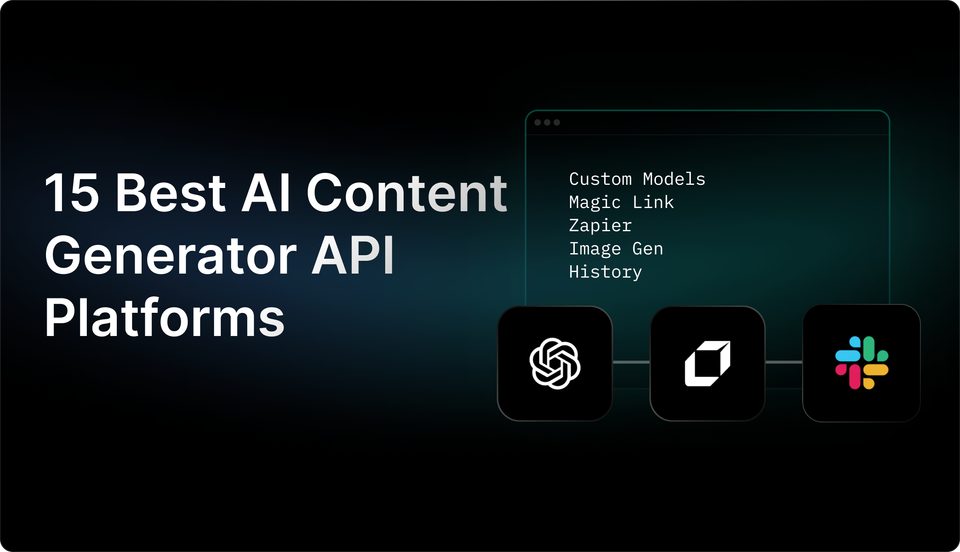43 Must-Have Content Automation Tools for Digital Marketers
Don't waste time on repetitive content tasks. Explore our list of content automation tools that will revolutionize your digital marketing strategy.

Are you tired of spending countless hours creating content? Content automation tools can do the heavy lifting for you. These tools streamline your content creation process by automating tedious tasks and boosting your productivity. Say goodbye to manual content ideation and repetitive writing tasks. Keep reading to discover how content automation tools can transform your content creation strategy!

What Is Content Automation & Why It Matters

Content automation tools are integral in today's digital age, allowing brands to streamline and optimize their content creation and distribution processes. Leveraging the power of technology and artificial intelligence, these tools automate repetitive tasks, enhance accuracy, and boost efficiency in content production.
Efficiency and Time Savings
Utilizing content automation tools significantly reduces the time and effort required for manual content creation and management. By automating repetitive tasks, content creators can allocate their time to higher-value activities such as strategy development and creative ideation.
Consistency and Quality
Maintaining a consistent tone, style, and messaging across various content platforms is crucial for upholding brand identity. Content automation tools help achieve this consistency and reduce the likelihood of errors, resulting in higher-quality content that resonates with the target audience.
Personalization and Improved User Experience
Content automation tools, powered by AI and data analysis, enable brands to create personalized content tailored to individual user preferences and behavior. This personalized approach leads to higher engagement levels and an improved overall user experience.
Scalability and Adaptability
Businesses can quickly scale their content production efforts to meet increasing demands or adapt to changing market trends with the help of content automation tools. This scalability allows for flexibility in content creation without a corresponding increase in resources or cost.
Data-Driven Decision Making
AI-driven content automation provides valuable insights into content performance, allowing businesses to make data-informed decisions and adjustments to their content strategy. By leveraging these insights, brands can drive better results and achieve a higher return on investment.
Competitive Advantage
Embracing content automation can provide businesses with a competitive edge. By automating content creation and distribution processes, brands can produce more relevant and engaging content at a faster pace than competitors who rely solely on manual processes.

What Is a Content Automation Tool?

A content automation tool is a type of software designed to help automate various aspects of the content management process including creation, distribution, and analysis of content. These tools are part of the broader category of marketing technologies but are distinct in their focus on automating content-specific tasks.While other marketing tools might concentrate on areas such as customer relationship management (CRM), email marketing, or social media scheduling, content automation tools specifically address the needs around generating, managing, and analyzing content. For instance, while a CRM tool manages interactions with customers and prospects, a content automation tool might use information from a CRM to generate personalized content at scale.
Supporting Content Creation
Content automation tools assist in creating content by providing features such as AI-driven writing assistants, template-based content generation, and dynamic content customization. These tools can automatically generate written content, suggest edits, optimize for SEO, and even produce multimedia content like images and videos, often using sophisticated AI algorithms to enhance creativity and adherence to brand guidelines.
Assisting in Content Distribution
In terms of distribution, these tools automate the scheduling and posting of content across various channels including blogs, social media platforms, and email newsletters. This ensures that content reaches the right audience at the optimal time without manual intervention. Integration with analytics platforms also allows these tools to adjust publishing schedules based on audience engagement data.
Enabling Content Analytics
On the analytics side, content automation tools provide insights into content performance across different platforms. They can track metrics such as views, engagement rates, and conversion statistics, and use this data to refine content strategies. Advanced tools might even offer predictive analytics to forecast the potential success of content pieces before they are published.
Related Reading
12 Key Components of Content Automation Systems

1. Automated Content Creation
Automated content creation is shaking up the way we produce written material. Rather than relying solely on human writers, content automation systems are using advanced algorithms and artificial intelligence to generate articles, blogs, and even reports. These systems can analyze data and create personalized content at scale, saving time and effort.
2. Template-based Generation
Template-based generation is a key feature of content automation systems. These systems allow users to generate content quickly and efficiently by using pre-designed templates. Templates serve as a blueprint, providing a structure for the content and ensuring consistency across multiple pieces. By filling in the required fields within a template, content creators can easily produce content without the need for extensive manual work.
3. Dynamic Variables
Dynamic variables refer to placeholders that can be inserted into content templates within a content automation system. These variables allow for the auto-population of specific information into the templates, avoiding manual input and saving time.
4. Efficient Content Management
Efficient Content Management is essential for maximizing productivity in content automation systems. By streamlining the process of creating, organizing, and delivering content, businesses can save valuable time and resources.
5. Centralized Storage
Centralized storage is a core feature of content automation systems. It serves as a centralized repository for all types of content, including text, images, videos, and documents.
6. Version Control
Version control is a crucial aspect of content automation systems. It allows users to track and manage changes made to their content over time.
7. Streamlined Collaboration
Content automation systems facilitate seamless collaboration among team members by centralizing the content creation and management process.
8. Real-time Editing and Reviewing
Real-time editing and reviewing a key features of content automation systems. With this capability, users can collaborate and make changes to content simultaneously.
9. Task Assignments and Notifications
Task Assignments and Notifications are integral components of content automation systems. With easy-to-use interfaces, these systems enable users to assign tasks to team members efficiently.
10. Seamless Integration
Content automation systems offer seamless integration with existing platforms, ensuring a smooth workflow.
11. Third-party Integrations
Content automation systems often support third-party integrations, which allow users to connect their system with other tools or platforms.
12. API Access
API Access is a crucial feature of content automation systems, allowing them to interact with other software applications.
6 Types of Content Automation Tools

1. Content Creation Tools
These tools automate the process of generating content. They use AI and machine learning to create written content, videos, graphics, and even social media posts. Examples include AI writing assistants, video production platforms that use AI to script and edit videos, and graphic design tools that automatically generate visuals based on predefined templates.
2. Content Management Systems (CMS)
A CMS helps in organizing and managing digital content. Automation features in a CMS can include workflow automation, where tasks are automatically assigned and managed across different teams. This might involve scheduling content for release, integrating SEO enhancements, and ensuring content is updated across all platforms.
3. Content Distribution Tools
These are designed to automate the scheduling and posting of content across various channels such as social media, blogs, and email marketing platforms. They ensure that content is distributed efficiently to the right channels at the optimal times, often utilizing data to determine the best release schedules.
4. Content Curation Tools
Automation tools for content curation help discover, organize, and share content from various sources. These tools often come with features to tag and categorize content automatically, making it easier to repurpose existing content across different platforms.
5. Content Personalization Tools
These tools use data about the audience to automatically tailor content to individual preferences, behaviors, or past interactions. This can range from dynamic content on websites that changes based on the viewer's profile, to personalized email content that addresses the recipient by name and references their specific interests.
6. Analytics and Reporting Tools
Tools in this category automate the collection and analysis of data on how content performs. They track metrics like views, engagement, and conversions, providing insights that help refine content strategies. These tools often feature dashboards that present key performance indicators in an easily digestible format.
43 Top Content Automation Tools for 2024

1. Leap AI
Leap helps you to automate your work with the power of AI. Partnered with Zapier, Vercel, and more, Leap enables you to supercharge your work by allowing you to create custom AI automations. Create sophisticated AI automations with no-code. Connect the tools you love with best-in-class AI text, image, and audio models.
Supercharge your existing tools with seamless AI integrations to OpenAI, Microsoft, and more. From summarizing documents, to voice translation, to AI call transcription, to AI avatar and asset generation, to SEO automation, to even automating the cold email creation and sending process, automate anything with Leap Workflows. The opportunities for automation are endless with Leap workflows.
Try Leap’s AI Workflows tool for free today.
2. ContentBot
An advanced tool that employs AI to create compelling content, saving you time and enhancing your content quality
3. ChatGPT
A powerful content generator that uses AI to produce pertinent content, streamlining your content creation process
4. Jasper
One of the original AI writers, now an industry-leading solution for teams
5. Writer
Writer is one of the few AI writers heavily skewed toward enterprises
6. QuillBot
QuillBot's paraphrasing tool helps millions of people rewrite and enhance any sentence, paragraph, or article using state-of-the-art AI.
7. Copysmith
Copysmith is an AI copywriting software for creating marketing-related content, such as product descriptions, Google ads, social media ads, blog posts and so much more.
8. Peppertype
Peppertype is an AI writing software for automating content creation. It’s a good option if you are a freelance writer, but the major downside is that it doesn’t create long-form content.
9. ClosersCopy
ClosersCopy is an AI content generator for creating different marketing copy types. It creates both short-form and long-form content.
10. Akkio
Akkio's AI-driven platform offers powerful content analysis capabilities. It can generate reports and output insights in a digestible format, helping you understand the performance of your content marketing process. You can try Akkio for free.
11. BuzzSumo
BuzzSumo offers content insights by analyzing what content performs best for any topic or competitor in your space.
12. SEMrush
SEMrush provides a comprehensive suite of tools for content analysis, including keyword research, site audits, and competitor analysis.
13. UpContent
An efficient tool that allows marketers to discover, collaborate, and distribute curated content to increase visibility and engagement.
14. Pixlee
A user-generated content marketing platform that enables brands to collect, analyze, and showcase user-generated content from their audience.
15. Hootsuite
A comprehensive platform that allows scheduling and publishing posts to multiple social media channels from one integrated dashboard.
16. SocialPilot
This tool offers a simple and efficient way to schedule social media posts, manage social strategies, improve engagement and analyze results at a pocket-friendly cost.
17. Scoop.it
A content curation tool that allows you to easily find, analyze and share relevant content to your social networks, website or blog.
18. Buffer
This tool makes it easy to schedule posts, track the performance of your content, and manage all your accounts in one place.
19. Sprout Social
This tool offers a single platform for social media management. It helps to streamline and enhance your social media efforts with its powerful scheduling, monitoring, and reporting features.
20. Later
Known for its visual content calendar and Instagram platform, Later allows you to plan and schedule your photos and videos across various social media platforms.
21. ActiveCampaign
Known for its customer experience automation (CXA) platform, ActiveCampaign offers a suite of tools for email marketing, marketing automation, sales automation, and CRM.
22. HubSpot
HubSpot provides a full platform of marketing, sales, customer service, and CRM software to help businesses grow.
23. Marketo
An Adobe Software, Marketo offers a complete marketing automation software solution that is powerful and easy to use.
24. Pardot
Pardot, a Salesforce software, provides a full suite of tools that help marketers create meaningful connections, generate more pipeline, and empower sales to close more deals.
25. Mailchimp
Known for its email marketing service, Mailchimp also offers a variety of marketing automation tools that can be used to create, send, and track email
26. Outbrain Amplify
This tool automates the distribution of content across multiple channels, expanding your reach and engagement.
27. Taboola
Similar to Outbrain, Taboola is another platform that maximizes your content's reach by distributing it across various channels.
28. Zemanta
This tool allows you to manage multiple campaigns across different networks, ensuring your content reaches a broader audience.
29. Einstein AI
This tool provides a customized user experience by scrutinizing customer data and behaviors, delivering content that resonates with each user.
30. Dynamic Yield
Offers AI-based personalization, optimization, and merchandising tools, tailoring content to the user's needs and preferences.
31. Optimizely
Known for its experimentation and personalization platform, it helps businesses test, learn, and deploy successful digital experiences.
32. Airtable
This is a flexible tool that works like a spreadsheet but gives the power of a database to organize anything.
33. Asana
A project management app designed to help teams organize, track, and manage their work.
34. Trello
This tool uses boards, lists, and cards to enable you to organize and prioritize your projects in a flexible and rewarding way.
35. Grammarly
An online writing assistant that helps detect potential grammar, spelling, punctuation, word choice, and style mistakes in writing, with premium features offering even more detailed feedback.
36. Hemingway App
An editing tool that highlights complex sentences, adverb overuse, and passive voice, helping to make your writing clear and engaging.
37. ProWritingAid
A grammar checker, style editor, and writing mentor in one package, offering in-depth reports to help you strengthen your writing.
38. Moz
A comprehensive SEO toolset that provides keyword research, link building, site audits, and page optimization insights, to help you improve your website's visibility and ranking.
39. Ahrefs
A well-rounded SEO tool that provides an extensive range of functionalities including keyword research, competitive analysis, and backlink research, to help you improve your SEO performance.
40. Google Analytics
A comprehensive tool that provides detailed insights into user behavior, engagement levels, and traffic sources, helping you understand what resonates with your audience.
41. Mixpanel
This tool offers user analytics for mobile and web, providing insights into user engagement and the effectiveness of different features or updates.
42. Heap
Heap automatically captures every user interaction on your website or app, allowing you to analyze user behavior and optimize for better engagement.
43. Upfluence
Upfluence offers powerful search capabilities to identify influencers based on keywords, geolocation, and more. It also provides useful insights into each influencer's audience.
Related Reading
- Content Scaling
- Content Automation
- Content Workflow
- Content Marketing Automation
- How To Make Ai Content Undetectable
- How To Train Chatgpt To Write Like You
- Content Marketing Workflow
- Best Instagram Automation
- Ai Powered Content Creation
- Ai Content Optimization
- Content Planning For Social Media
- Ai Content Management
- Ai And Content Marketing
- Content Production Process
- How To Automate Content Creation
- Automate Blog Posts
- Cost Effective Content Marketing
Common Challenges and Solutions in Content Automation

Lack of Quality Control in Content Automation
One significant challenge in content automation is the lack of quality control. With automation tools, it becomes easier to generate a large quantity of content quickly. This speed often comes at the expense of quality. Automated systems lack the ability to assess and maintain the same level of quality as human writers. They may produce inaccurate or poorly written content, leading to a negative impact on the overall reputation and credibility of the organization.Ensuring proper quality control measures, such as human oversight and editing, becomes crucial to mitigate this challenge and maintain high-quality content output.
Human Oversight in Content Creation
The importance of human oversight in content creation cannot be underestimated in the face of content automation challenges. Here's why:
Maintaining quality
While automation can efficiently produce content, it lacks the nuanced understanding, creativity, and critical thinking abilities of humans. Human oversight ensures the quality and relevance of content, enhancing its value to readers.
Adaptability to context
Humans possess the ability to consider the ever-changing social, cultural, and political landscape, enabling them to adapt content accordingly. They can blend sensitivity and contextuality to avoid producing content that may be offensive or inappropriate.
Building trust and credibility
Content produced solely by automation risks appearing impersonal, lacking authenticity, and undermining trust. Human oversight adds a personal touch, authenticity, and a human voice that resonates with readers, increasing trustworthiness and credibility.
Ethical considerations
Humans are capable of ethical decision-making, understanding nuances, and considering the potential impact of content. They ensure adherence to guidelines, maintain ethical standards, and prevent the dissemination of harmful or misleading information.
Best Practices for Maintaining Quality in Content Automation
To maintain quality in content automation, there are a few best practices to follow.
- Have a well-defined content strategy that outlines the goals and objectives.
- Ensure that the content is accurate and up to date by regularly reviewing and updating it.
- It's important to monitor the automation process and analyze the results to identify any issues or gaps.
- Don't overlook the importance of human intervention and editing to add that personal touch and ensure the content is engaging and relevant.
By following these practices, content automation can maintain its quality and effectiveness.
Managing Data Accuracy and Relevancy in Content Automation
One of the key challenges in content automation is managing data accuracy and relevancy. Here are some important considerations
Regularly validate data sources
It is crucial to verify the information coming from various sources to ensure accuracy. Implement checks and balances to weed out any outdated or incorrect data
Establish data quality standards
Define clear guidelines for data accuracy and relevancy that align with your content objectives. This ensures consistency and helps reduce errors
Utilize data cleansing techniques
Employ data cleansing methods to eliminate duplicate or irrelevant data. This helps in maintaining data accuracy and improves the overall quality of your content
Monitor and update data
Continuously monitor the data sources for any changes or updates. Regularly updating your data helps to ensure its relevancy and reliability
Leverage automation tools
Capitalize on automation tools that can handle data validation, cleansing, and management tasks efficiently. These tools streamline the process and reduce manual effort.
Data Integration's Role in Content Automation
Data integration plays a crucial role in content automation, helping to overcome various challenges associated with this process. Here's how it contributes
Efficient data management
Integration enables the collection, organization, and consolidation of data from various sources into a unified format. This allows for easier access and analysis, creating a solid foundation for automated content generation
Enhanced accuracy
By integrating data, organizations can ensure that the information used in content automation is accurate and up-to-date. This helps in minimizing errors and producing high-quality output
Seamless workflow
Data integration streamlines the flow of information across different systems and applications. It enables data to be seamlessly exchanged between various platforms, making the automation process more efficient and effective
Personalized content
By integrating customer data, content automation can be tailored to individual preferences, leading to more personalized and engaging content.
Tips for Ensuring Accurate and Relevant Data in Automated Content
Establish reliable data sources
Utilize trusted databases, official websites, and reputable sources to gather data for automation
Regularly update data feeds
Ensure your automated content pulls information from up-to-date sources by regularly refreshing data feeds
Cleanse and normalize data
Remove any duplicate, incomplete, or inconsistent data from your sources to maintain accuracy. Normalize data formats for seamless integration.
Implement validation checks
Use validation rules and algorithms to identify and rectify errors, improving the accuracy of your automated content
Leverage machine learning
Utilize machine learning algorithms to detect patterns and outliers, reducing the risk of inaccurate data
Establish quality control processes
Implement manual review checkpoints to verify the accuracy and relevance of automated content before publication
Monitor feedback and make necessary adjustments
Continuously monitor user feedback and analytics to identify any discrepancies or areas of improvement, enabling you to refine your automated content.
How to Choose the Right Content Automation Tools

Identifying Your Business Needs
When considering content automation tools for your business, it's essential to start by understanding your goals and defining your objectives. Do you want to enhance efficiency, boost productivity, or streamline workflows? Your goals will guide you in selecting the right tools and processes for your business.
Assessing Current Content Processes for Improvement Opportunities
Analyze your current content process to identify pain points, bottlenecks, and areas that need improvement. This assessment will help you understand the specific challenges you need to address and guide you toward the most suitable content automation solutions.
Choosing Automation Solutions for Future Growth
Always consider the scalability and growth potential of the tools you choose. Will your content demands increase as your business expands? Ensure that the automation system you choose can scale with your growing needs, accommodating larger volumes of content while maintaining quality and efficiency.
Gathering Input for Effective Content Automation
Involve key stakeholders from various departments to gather their input on content automation needs. Collaborating with stakeholders provides valuable insights and ensures that the chosen solution meets everyone's requirements.
Understanding the Costs of Implementing Content Automation
Evaluate the financial implications of implementing content automation, including the costs of necessary software, training, and ongoing support. Be sure to assess if you have the resources, both human and technological, to deploy and maintain the automation process effectively.
Understanding your business needs is crucial for establishing an effective content automation strategy that aligns with your objectives and drives success.
Evaluating Features and Functionality
When assessing content automation tools, key aspects to consider include:
- User-friendly interfaces
- Wide range of templates
- Customization options
- Integration capabilities
- Analytics/reporting capabilities.
The software should offer intuitive and user-friendly interfaces, making it easy for non-technical users to navigate. It should provide a wide range of templates and customization options to suit different content needs.
The ability to integrate with existing systems and tools is crucial for a seamless workflow. Analytics and reporting capabilities are essential for tracking performance and making data-driven decisions. By carefully assessing these factors, you can select a content automation solution that aligns with your specific requirements and enhances your content creation process.
Considering Integration Capabilities
When evaluating content automation solutions, it is crucial to consider their integration capabilities.
- Evaluate whether the solution integrates smoothly with existing systems, such as CMS, CRM, or DAM platforms.
- Check if the solution offers well-documented APIs for easy integration with other applications.
- Assess the ecosystem of available integrations, such as marketing automation or social media platforms, to extend the functionalities.
- Verify if the solution supports real-time data synchronization across integrated systems.
- Look for the ability to trigger automation processes based on specific events or actions within integrated applications.
- Consider whether the solution allows for custom integrations to meet unique business requirements.
- Ensure that the integration capabilities can accommodate future growth and evolving technology needs.
By considering the integration capabilities of content automation solutions, organizations can streamline their processes and enhance overall productivity.
Assessing Scalability and Performance
To ensure smooth content automation processes, scalability and performance must be carefully evaluated. Scalability refers to the system's ability to handle increasing workloads, while performance measures its efficiency and responsiveness. Assessing scalability involves analyzing the system's capacity to accommodate growing demands, ensuring it can handle larger volumes of content without compromising speed or functionality.
Performance assessment involves testing the system's response times, latency, and resource usage under various workloads. By thoroughly evaluating scalability and performance, organizations can identify potential bottlenecks, optimize resource allocation, and ensure a seamless content automation experience.
Comparing Pricing and Support Options
Pricing models in content automation are essential for budgeting and decision-making. There are different approaches to consider.
- Fixed pricing offers a set price for specific services or software licenses. This allows for better cost control but may limit flexibility.
- Usage-based pricing, on the other hand, charges according to the amount of content processed, giving more flexibility but potentially increasing costs.
- Subscription-based models provide access to certain features or content for a recurring fee. It's important to evaluate these models based on your specific needs and the expected volume of content to ensure cost-effectiveness and scalability.
When it comes to evaluating support and training offerings in the context of content automation processes, it can be beneficial to consider the following points:
- Check if the vendor offers timely support and training resources, such as online documentation, video tutorials, or a dedicated helpdesk.
- Evaluate the level of expertise the vendor's support team possesses. Are they knowledgeable about the product and its functionalities?
- Determine if the vendor can provide customized training programs to address your specific content automation needs.
- Look for feedback channels to provide comments or suggestions on support and training, ensuring continuous improvement.
- Consider reading reviews or testimonials from existing clients to understand the effectiveness of the vendor's support and training offerings.
Related Reading
- Midjourney Alternatives
- Ai Content Creation Tools
- Best Linkedin Automation Tools
- Social Media Automation Tools
- Writesonic Alternative
- Copy Ai Alternatives
- Jasper Ai Alternative
- Rytr Alternatives
- Wordtune Alternatives
- Ai Content Generator Api
- Content Automation Services
- Frase Alternative
Create Game Changing Automations Today With Leap’s AI Workflows

Leap is a cutting-edge tool that harnesses the power of AI to help automate your tasks. Through seamless integration with Zapier, Vercel, and other platforms, Leap lets you create custom AI automations without needing to write a single line of code. It provides access to top-tier AI text, image, and audio models, enabling you to develop intricate AI automations that address your specific needs.
With connections to major AI providers like OpenAI and Microsoft, Leap empowers you to enhance your current tools with AI capabilities. Whether you need to summarize documents, translate text to voice, transcribe calls, generate AI avatars, automate SEO tasks, or streamline cold email creation and sending, Leap's AI Workflows can help you achieve it all.
The possibilities for automation are boundless - Leap's AI Workflows tool is available for you to try for free right now.




